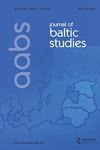爱沙尼亚消费的种族隔离:神话和实践
IF 0.5
4区 社会学
Q2 AREA STUDIES
引用次数: 0
摘要
摘要居住在爱沙尼亚的俄语和爱沙尼亚语人口之间的消费隔离在大众想象、大众媒体出版物和学术论文中已经成为常识。在这篇文章中,我没有承担一个不可能完成的任务来确定这些故事是否真实,而是展示了这些故事是如何培养特殊的营销策略的,并记录了一个特殊的营销利基的出现,这些公司承诺教人们如何根据他们假定的心理差异向主流或少数消费者推销产品。根据人种学的田野调查,我展示了关于消费中种族隔离的神话是如何矛盾地导致融合的。关键词:民族融合民族隔离同化俄语神话消费民族志研究披露声明作者未报告潜在利益冲突。这项工作得到了爱沙尼亚研究委员会资助项目PSG48“当代爱沙尼亚归属感的表演性谈判”和PSG729“COVID-19阴谋论:内容、渠道和目标群体”的支持。作者简介:anastasiya Astapova,爱沙尼亚塔尔图大学民俗学副教授,爱沙尼亚青年科学院院士。她是《后苏联专制国家的幽默和谣言》(罗曼和利特菲尔德,2021年)的作者,《东欧阴谋论:修辞和趋势》(劳特利奇,2021年)的合著者,《阴谋论和北欧国家》(劳特利奇,2020年)的合著者。目前,Astapova是爱沙尼亚科学基金会项目“COVID-19阴谋论:内容,渠道和目标群体”(2022-2025)的首席研究员。本文章由计算机程序翻译,如有差异,请以英文原文为准。
Ethnic segregation of consumption in Estonia: mythologies and practices
ABSTRACTThe segregation of consumption between the Russian- and Estonian-speaking populations residing in Estonia has been common knowledge in the popular imagination, mass media publications, and academic papers. Rather than undertaking an impossible mission to identify whether these narratives are true, in this article, I show how this repertoire of stories has fostered special marketing strategies and document the emergence of a special marketing niche of companies promising to teach how to market products to mainstream or minority consumers based on their presumed mental differences. Deriving from ethnographic fieldwork, I demonstrate how mythologies about ethnic segregation in consumption paradoxically result in integration.KEYWORDS: Ethnic integrationethnic segregationassimilationRussian speakersmythologyconsumptionethnographic research Disclosure statementNo potential conflict of interest was reported by the author(s).Additional informationFundingThis work was supported by the Estonian Research Council grants PSG48 “Performative Negotiations of Belonging in Contemporary Estonia” and PSG729 “COVID-19 Conspiracy Theories: Contents, Channels, and Target Groups.”Notes on contributorsAnastasiya AstapovaAnastasiya Astapova is an Associate Professor of Folkloristics (University of Tartu, Estonia) and a member of the Estonian Young Academy of Sciences. She is the author of Humor and Rumor in the Post-Soviet Authoritarian State (Rowman and Littlefield, 2021), a co-editor of Conspiracy Theories in Eastern Europe: Tropes and Trends (Routledge, 2021), and a co-author of Conspiracy Theories and the Nordic Countries (Routledge, 2020). At the moment, Astapova is the principal investigator in the Estonian Science Foundation project “COVID-19 Conspiracy Theories: Contents, Channels, and Target Groups” (2022–2025).
求助全文
通过发布文献求助,成功后即可免费获取论文全文。
去求助
来源期刊

Journal of Baltic Studies
AREA STUDIES-
CiteScore
1.20
自引率
0.00%
发文量
52
期刊介绍:
The Journal of Baltic Studies, the official journal of the Association for the Advancement of Baltic Studies (AABS), is a peer-reviewed, multidisciplinary journal for the purpose of advancing the accumulation of knowledge about all aspects of the Baltic Sea region"s political, social, economic, and cultural life, past and present. Preference is given to original contributions that are of general scholarly interest. The Association for the Advancement of Baltic Studies is an international, educational, and scholarly non-profit organization. Established in 1968, the purpose of the Association is the promotion of research and education in Baltic Studies.
 求助内容:
求助内容: 应助结果提醒方式:
应助结果提醒方式:


